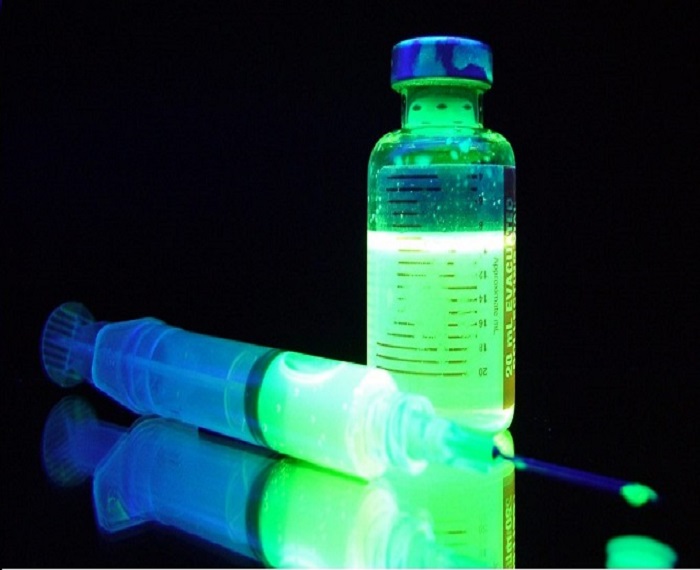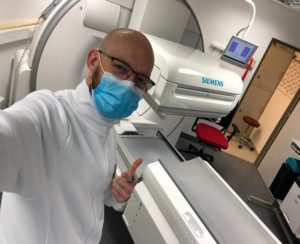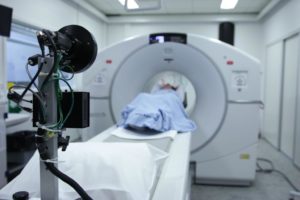
Nuclear Medicine
Myocardial scintigraphy is used for the non-invasive measurement of the blood flow to the heart muscle. A reduced blood flow, for example due to a critical narrowing of the coronary arteries in coronary artery disease (CHD), can be demonstrated by imaging. Furthermore, the necessity or the success of a therapy, for example a balloon dilatation, stent insertion or bypass operation, can be investigated.
-Pectanginal complaints with normal stress ECG or stress ECG that cannot be assessed due to bundle branch block
You should not eat about 6 hours before the start of the examination. Please bring a high-fat meal with you to consume between the examinations (e.g. chocolate croissants, cheese sandwiches, milkshake). You should not drink caffeinated drinks or smoke three hours before the examination. Please bring all relevant preliminary examinations with you: CDs, written reports and medical reports. Some medications must be paused (sometimes for several days) before the examination or taken again during the examination. Please inform our registration about your current medication when making an appointment.
The examination begins with a stress test, which is carried out using a bicycle ergometer or a drug. During this phase, a weakly radioactive substance is applied. In the following half-hour break, you can take your own meal. This is followed by a recording with a gamma camera for approx. 20 minutes. For a resting examination, the radiopharmaceutical is administered a second time, this time without physical or medication stress. Here, too, a high-fat meal should be eaten afterwards, before pictures are taken again after 30-60 minutes.

The diagnosis of the thyroid gland includes both imaging and laboratory tests to clarify various thyroid diseases. These include, among others. the overactive or underactive thyroid gland (hyperthyroidism or hypothyroidism), nodular changes in the thyroid gland, specific autoimmune diseases (Graves’ disease, Hashimoto’s thyroiditis) and thyroid cancer. An ultrasound examination (sonography), a blood sample to check the thyroid values and, depending on the question, a thyroid scintigraphy can be used as part of the outpatient visit. In some cases, a fine needle aspiration of the thyroid may also be indicated.
Please bring all relevant preliminary examinations with you: preliminary scintigraphic findings (as color printouts), CDs, written findings and doctor’s letters.In general, no special preparation is required for a presentation in the thyroid clinic. Special features apply to individual partial examinations:
Thyroid scintigraphy: Iodine-containing drugs or a recent dose of iodine-containing X-ray contrast media may interfere with the examination. When making an appointment, please indicate if you are taking medication containing iodine (e.g. amiodarone) or if you have received contrast media in the last few months (e.g. for computed tomography or a cardiac catheter examination).

The examination serves to visualize the thyroid metabolism and its distribution over the entire organ. A weakly radioactive drug is administered for this purpose. After 20 minutes, a gamma camera takes about 5 minutes of images over the neck region.
Here, too, a radiopharmaceutical is injected, which accumulates in the thyroid gland or in atypically located parts of the thyroid gland. After an exposure time of a few hours, the distribution in the entire body is measured with a gamma camera. In individual cases, additional recordings may be required on the following day. The radiopharmaceutical cannot be stored and must be used at the planned time. Therefore, please be sure to keep your appointment or cancel it at least 3 days in advance.
The 99mTc-MAG3 kidney scintigraphy is used to examine the tubular kidney function, e.g. in the case of disorders of the urinary flow, the determination of the laterally separated kidney function and the diagnosis of renal artery stenosis. Furthermore, the 99mTc-MAG3 kidney scintigraphy can be used for functional control after kidney transplants and operations on the kidneys or urinary tract.
Indication
-Control under therapy with drugs that can cause kidney damage
-Hypertension (renovascular hypertension – scintigraphy with captopril administration)
– Unilateral kidney damage, acute kidney failure, chronic kidney disease
-Graft kidney disease.
-pre- and postoperative functional control
– Urinary congestion kidneys
-Therapy control
-Cystic kidneys
– Consequential damage after kidney trauma.
Preparation
Please drink sufficient liquid (approx. 0.5 to 1 liter of water) before the examination. Infants should be breastfed / fed immediately prior to the examination. Please bring all relevant preliminary examinations with you: CDs, written reports and medical reports.
With a few exceptions, medication can be taken as usual. Please inform our registration about your current medication plan when making an appointment.

Procedure of the investigation
After the application of a radiopharmaceutical, pictures are taken over a total of approx. 45 minutes. During this time you should lie quietly in order to enable optimal image quality. Depending on the findings, it may be necessary to give a diuretic drug (furosemide). Two blood samples are also taken during the examination to determine the excretory function.



